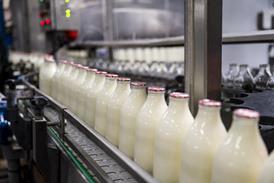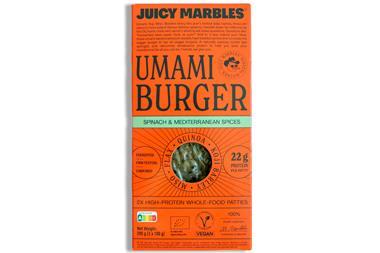The multiples protest that food is sacrosanct, so where will the space come from that will allow them to take their sales of non-food to a predicted £20bn by 2007? Helen Gregory reports
Supermarkets are the department stores of the future. Sounds far-fetched? Not when some are already half full of non-food. They may be grocers by trade, but it might not be long before they’re asking shoppers, ‘Are you being served?’
Food retailers are now pushing their homeware, electronics and clothing ranges hard where the margins are considerably higher than on groceries.
They already have dominant shares in categories such as health and beauty, cut flowers and batteries and racked up total non-food sales of £11.6bn last year.
This represents a 10.7% share of the £108bn market, which Verdict reckons they’ll be able to increase to 12.9% by 2007, taking sales to almost £20bn.
But all the multiples - particularly Sainsbury, Tesco and Asda - have big expansion plans for non-food which, because of the tough planning laws, clearly are not often going to come from store extensions.
So are they sacrificing grocery floorspace to the cause? Something surely has to give if they are to accommodate expanded non-food offers.
Tesco boasts that it sells more volume of medicines and toiletries than Boots and Superdrug combined and more chart CDs than Woolworths or Virgin. Never one to set its sights low, it aims to be as strong in non-
food as it is in food. Sainsbury, too, underscored its intent to go for a bigger share of the non-food market in September with the launch of its Homeware range and it is now rolling out a full range of non-food - including a revamped clothing offer and expanded kids range - to 220 stores, as well as aspects of this across its whole estate.
Somerfield, meanwhile, recently rolled out its non-food range branded Somerfield at Home to 85 larger stores and 190 Kwik Save stores.
This growth isn’t coming from a few gondola ends full of socks and candles - considerable space is needed to display non-food credibly.
Shoppers like to browse through large, varied ranges, with good point of purchase information and trained staff to make them feel confident enough to part with their cash. That is why Asda and Safeway’s larger destination stores have always looked a more attractive proposition.
However, the retailers insist that they are not eating into their food offer. They admit they are hampered by the planning regime, but point to mezzanine floors, store refurbishments and the paring down of backroom operations to shoehorn in jeans and TVs as examples of ways in which they can juggle square feet.
Manufacturers are sceptical. In one initiative in bedding, supplier John Cotton has worked with retailers such as Asda and Tesco on innovations that keep space to a minimum in the supply chain by squashing pillows that can subsequently be revived in store.
John Cotton’s business development director Neil O’Shea recognises the products are bulky and take up vital shelf space, but says shoppers don’t like buying flattened duvets.
“Consumers also need more of a choice in bedding so the category will need even more space in future to display the different ranges - but I don’t know where that will come from.”
The answer, surely, has to be food. If the retailers want to continue chasing non-food growth, there will come a time when they will start eating into the slowest-moving groceries - if indeed, they haven’t already done so.
According to Mintel, retailers are increasingly taking lower margins for non-food as they turn these markets into higher-volume categories - which
reinforces the need for more space.
Verdict senior analyst Steve Gotham reckons Asda for one has already been contracting grocery space.
“Non-food is the key in terms of market growth and profit growth,” he says. “It’s worth creating more space - such as mezzanine floors - and contracting food to put in more non-food.” Gotham believes that, in future, there will be a lot of close scrutiny of grocery ranges - particularly slower-moving ranges such as ambient and paper products - when every department will have to make out a strong case for their shelf space.
However, Asda believes it can make room for non-food without grocery sacrifices. “All our trading initiatives are about better utilising space,” says its space director, Sarah O’Sullivan.
But she insists: “We’re food retailers so food is sacrosanct and we would never jeopardise that.” She points to the many stores that had “big empty shelves gathering dust” in areas such as toiletries and says simply that they are making space sweat harder.
Tesco, Sainsbury and Asda may all be keen to talk about their enthusiasm for non-food, but they are reticent about exactly how much space they devote to it now, or will in the future, and about the ratio of non-food lines.
But they’ll need to have the figures at their fingertips if food manufacturers start questioning their intentions.
Unilever Bestfoods has already sounded a warning note.
It says that although it understands that non-food products offer an opportunity for growth in the short term and, within certain larger store formats, add value to the shopping experience, the industry should not forget why people visit supermarkets in the first place. And that is to buy groceries.
A company spokesman says: “For the industry as a whole it is vital that grocery remains our focus, otherwise there is a real risk we will damage our core consumer offering over the long term.”
Whatever has happened so far, the race for non-food domination will only quicken if Morrisons takes over Safeway and the major multiples look to offset margin pressure on food.
Morrisons has shown the best growth performance of any food retailer over the last five years. If it can transfer this success to non-food, the others will really need to watch this space.
Supermarkets are the department stores of the future. Sounds far-fetched? Not when some are already half full of non-food. They may be grocers by trade, but it might not be long before they’re asking shoppers, ‘Are you being served?’
Food retailers are now pushing their homeware, electronics and clothing ranges hard where the margins are considerably higher than on groceries.
They already have dominant shares in categories such as health and beauty, cut flowers and batteries and racked up total non-food sales of £11.6bn last year.
This represents a 10.7% share of the £108bn market, which Verdict reckons they’ll be able to increase to 12.9% by 2007, taking sales to almost £20bn.
But all the multiples - particularly Sainsbury, Tesco and Asda - have big expansion plans for non-food which, because of the tough planning laws, clearly are not often going to come from store extensions.
So are they sacrificing grocery floorspace to the cause? Something surely has to give if they are to accommodate expanded non-food offers.
Tesco boasts that it sells more volume of medicines and toiletries than Boots and Superdrug combined and more chart CDs than Woolworths or Virgin. Never one to set its sights low, it aims to be as strong in non-
food as it is in food. Sainsbury, too, underscored its intent to go for a bigger share of the non-food market in September with the launch of its Homeware range and it is now rolling out a full range of non-food - including a revamped clothing offer and expanded kids range - to 220 stores, as well as aspects of this across its whole estate.
Somerfield, meanwhile, recently rolled out its non-food range branded Somerfield at Home to 85 larger stores and 190 Kwik Save stores.
This growth isn’t coming from a few gondola ends full of socks and candles - considerable space is needed to display non-food credibly.
Shoppers like to browse through large, varied ranges, with good point of purchase information and trained staff to make them feel confident enough to part with their cash. That is why Asda and Safeway’s larger destination stores have always looked a more attractive proposition.
However, the retailers insist that they are not eating into their food offer. They admit they are hampered by the planning regime, but point to mezzanine floors, store refurbishments and the paring down of backroom operations to shoehorn in jeans and TVs as examples of ways in which they can juggle square feet.
Manufacturers are sceptical. In one initiative in bedding, supplier John Cotton has worked with retailers such as Asda and Tesco on innovations that keep space to a minimum in the supply chain by squashing pillows that can subsequently be revived in store.
John Cotton’s business development director Neil O’Shea recognises the products are bulky and take up vital shelf space, but says shoppers don’t like buying flattened duvets.
“Consumers also need more of a choice in bedding so the category will need even more space in future to display the different ranges - but I don’t know where that will come from.”
The answer, surely, has to be food. If the retailers want to continue chasing non-food growth, there will come a time when they will start eating into the slowest-moving groceries - if indeed, they haven’t already done so.
According to Mintel, retailers are increasingly taking lower margins for non-food as they turn these markets into higher-volume categories - which
reinforces the need for more space.
Verdict senior analyst Steve Gotham reckons Asda for one has already been contracting grocery space.
“Non-food is the key in terms of market growth and profit growth,” he says. “It’s worth creating more space - such as mezzanine floors - and contracting food to put in more non-food.” Gotham believes that, in future, there will be a lot of close scrutiny of grocery ranges - particularly slower-moving ranges such as ambient and paper products - when every department will have to make out a strong case for their shelf space.
However, Asda believes it can make room for non-food without grocery sacrifices. “All our trading initiatives are about better utilising space,” says its space director, Sarah O’Sullivan.
But she insists: “We’re food retailers so food is sacrosanct and we would never jeopardise that.” She points to the many stores that had “big empty shelves gathering dust” in areas such as toiletries and says simply that they are making space sweat harder.
Tesco, Sainsbury and Asda may all be keen to talk about their enthusiasm for non-food, but they are reticent about exactly how much space they devote to it now, or will in the future, and about the ratio of non-food lines.
But they’ll need to have the figures at their fingertips if food manufacturers start questioning their intentions.
Unilever Bestfoods has already sounded a warning note.
It says that although it understands that non-food products offer an opportunity for growth in the short term and, within certain larger store formats, add value to the shopping experience, the industry should not forget why people visit supermarkets in the first place. And that is to buy groceries.
A company spokesman says: “For the industry as a whole it is vital that grocery remains our focus, otherwise there is a real risk we will damage our core consumer offering over the long term.”
Whatever has happened so far, the race for non-food domination will only quicken if Morrisons takes over Safeway and the major multiples look to offset margin pressure on food.
Morrisons has shown the best growth performance of any food retailer over the last five years. If it can transfer this success to non-food, the others will really need to watch this space.














No comments yet